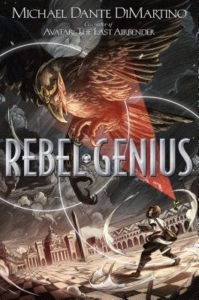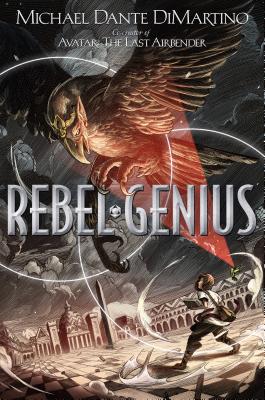Guest post by Colleen Riordan

Middle grade readers are deeply curious about the wider world and fascinated with the creative “what if” possibilities presented by magic. They often want to understand how the magic works, in order to imagine how it might fit into their own worlds. When creating a magical world, it can be tempting to explain the magic system’s intricacies through detailed descriptions, but middle grade readers aren’t likely to enjoy long sections of exposition. Instead, you can reveal the magical system in bits and pieces through action.
In Rebel Genius, Michael Dante DiMartino ties art and magic together. Orphaned Giacomo spends his days hiding in the sewers and trying to draw beautiful pictures like the artists of old. Years before, artists depended on the magic of their Geniuses, birdlike muses who amplified the effect of their art. However, Geniuses have been outlawed, and magic has disappeared. When Giacomo discovers his own Genius, he must go into hiding with other young artists and train in sacred geometry to channel their creative energies as weapons to save their Geniuses and their world. DiMartino uses the intrinsic magic of art to bring his magic system to life.
Magic does not need to be complex to be credible for the reader. You can create a believable magic system through the ways your characters interact with it.
Magic through Action, and Establishing Personal Stakes
When DiMartino first establishes his societal, environmental, and political systems in Rebel Genius, he introduces them indirectly. The magic system is no different. Our first hint at magic arrives early with the mention of a Lost Soul.
Giacomo crouched and peered out, the street at eye level. As he expected, the city looked empty. But any moment, a soldier might march by, patrolling for curfew breakers. Or worse, a Lost Soul could be lurking in the shadows, waiting to lunge at an unsuspecting victim (page 3).
Creating a unique proper noun for the Lost Souls immediately makes them stand apart and leaves the reader wondering what they are and why they would attack a child. They are dropped into the paragraph without fanfare, and DiMartino quickly moves the action along. By the end of the chapter, we learn that Giacomo’s own parents became Lost Souls after their Genuises were taken and destroyed. DiMartino reveals this, and explains what a lost soul is in the process, by describing Giacomo’s encounter with a Lost Soul.
A thin hand, more bone than flesh, rose out of the woman’s cloak and pointed at Giacomo. She crept closer, into the lantern’s light. Still he couldn’t move.
Her eyes stared not so much at him as through him. Her hollow gaze looked exactly like his mother’s and father’s in the weeks after their Geniuses had been taken away. He was five at the time, and their haunting expressions had been seared into his memory (page 10).
Lost Souls represent the loss of magic. Like the children cut from their dæmons in Philip Pullman’s The Golden Compass, the Lost Souls have become shadows of their former human selves. The reader learns about the boundaries of magic by seeing what happens when the source of magic is removed.
At this point in the story, Giacomo does not have his Genius. However, by the time it arrives, the reader already knows the personal stakes if it is taken from him.
Action: Use action to reveal how the magic works in your story, rather than exposition.
Action: Make a list of consequences for either the loss of magic or misuse of magic. Choose one (or more) to show the potential stakes for the protagonist before they struggle with that problem.
Demonstrate Through Lessons: Observation and Practice
Much of Giacomo’s story hangs on his journey to learn magic with his Genius, which is why the reader gets in-depth magic lessons. DiMartino separates Giacomo’s first magic lesson into two distinct halves of the scene. Because Giacomo is afraid to depend on others, the author is able to write a slow build up to the magic lesson, allowing the protagonist and the reader the chance to first observe and then participate in the magic.
First he observes: Giacomo arrives late to class and watches as his fellow artists practice the magic of sacred geometry under their teacher’s direction.
“Brushes up,” Pietro instructed.
Milena and Savina raised their paintbrushes in front of them as if they were about to lay the first strokes on a canvas, except they weren’t standing in front of easels.
“Picture a hexagon,” Pietro continued. “Visualize each of its six sides. Can you see it?” … “Now bring it to light.”
Savino and Milena both brushed six short strokes in the air, signaling their Geniuses to illuminate their gems. A brilliant blue light shot out of Nero’s crown and projected Savino’s hexagon into the center of the room. At least five feet tall, the hexagon’s bold, rough lines hung in the air as if cast against a wall. At the same time, Gaia projected a green light, forming an equally large hexagon, but with a thin delicate outline. Both colorful shapes hummed with energy, their edges vibrating; their centers were translucent, like a section of a stained glass window (page 67).
Then he participates: Once Giacomo is (uncomfortably) in his new world with a master artist and fellow students, he must quickly learn to collaborate with his Genius to master these techniques. Since Giacomo is merely an observer in the initial passage of magic lessons, DiMartino throws him headfirst into the second to increase the pace and drive the conflict.
“Then please, demonstrate your inspiring circle-drawing abilities for us,” Pietro’s voice was tinged with sarcasm.
“I’d love to, but I can’t draw anything with this stupid blindfold on.” Giacomo tugged at the knot, unable to loosen it.
“Leave it,” Pietro commanded. “To form a deeper connection with your Genius and unlock its true potential, you need to change your perception of reality.”
Giacomo dropped his hands to his sides and groaned. “Fine. So how do I do that exactly?” (page 70)
Both Giacomo and his mentor are driven toward the same goal: for Giacomo to learn magic. However, each character enters the scene in a particular mood. The author draws upon those emotions to make the characters clash while still working together. Giacomo is eager to catch up to his fellow artists and prove himself, but his mentor Pietro is irritated that his new student was late and disruptive. The conflict drives the chapter forward and keeps reader glued to the page. By aligning the magic lesson with the conflict, the author can provide detailed instructions without slowing the scene’s pace.
Action: List at least two distinct ways your protagonist could observe magic before participating in the practice. Choose different vantage points based on the character’s relationships with other characters in the scene. Are they inside the same room, aware of one another’s presence, or at the same skill level?
Magic doesn’t exist in a vacuum. Add credibility to your magic system by addressing the subtle ways that personalities and attitudes can affect it.
Action: Consider the mood of each character at the start of the scene. What happened to them (either on the page or off) just before this scene began? Jot down a few notes about how each character would express that mood. How do those attitudes influence the way your characters interact with magic in your scene?
Magic systems don’t require long expositions about their history and science. In middle grade fantasy, it’s important to focus on how your characters directly interact with the magic. By considering magic’s limitations and consequences, you can weave it into the plot. And by allowing a character to observe and to participate in magic, your reader can understand the magic in action.
Magic must be integral to the world you create, so make it integral to your story as well.
 Colleen Riordan is a digital marketer and freelance writer. She writes middle grade and young adult fantasy novels and has been a member of SCBWI since 2014. When she’s not studying plot structure, Colleen is usually playing trivia, stargazing, and taking solo cross-country roadtrips. Find her at cmriordan.com and on Twitter @olivewildly.
Colleen Riordan is a digital marketer and freelance writer. She writes middle grade and young adult fantasy novels and has been a member of SCBWI since 2014. When she’s not studying plot structure, Colleen is usually playing trivia, stargazing, and taking solo cross-country roadtrips. Find her at cmriordan.com and on Twitter @olivewildly.

Love this post. Very illuminating:)